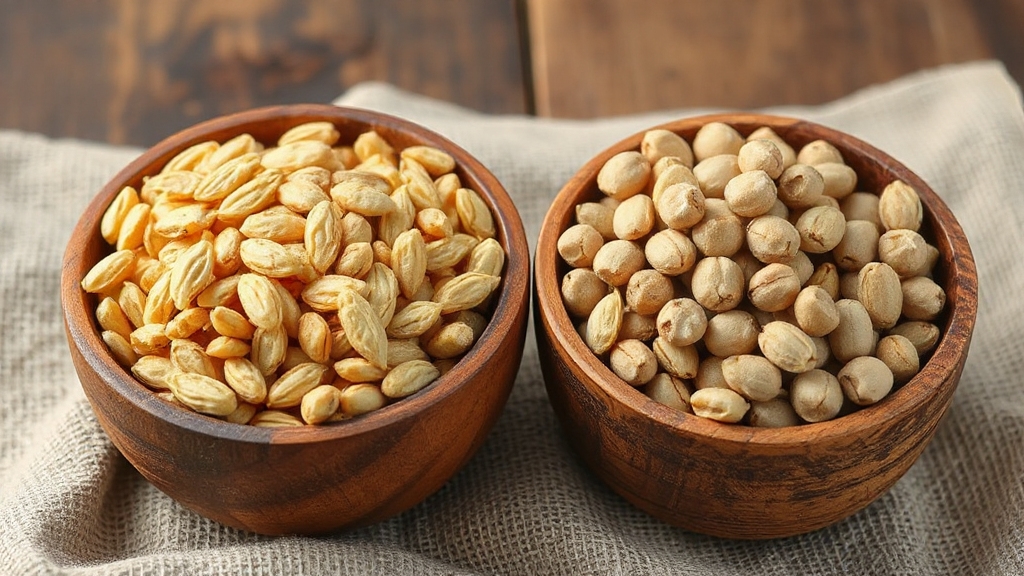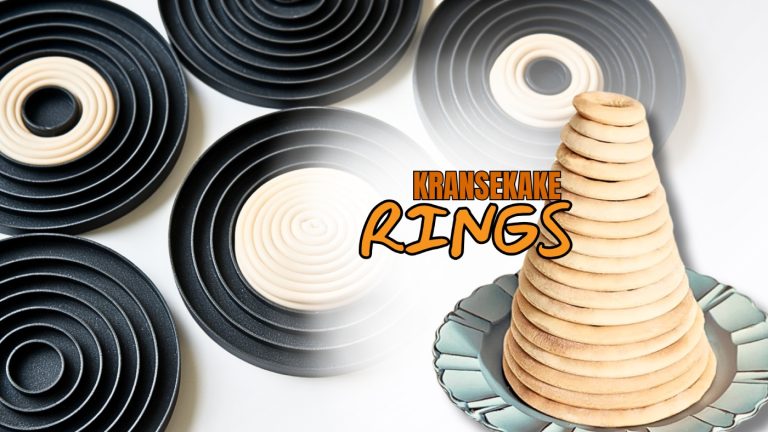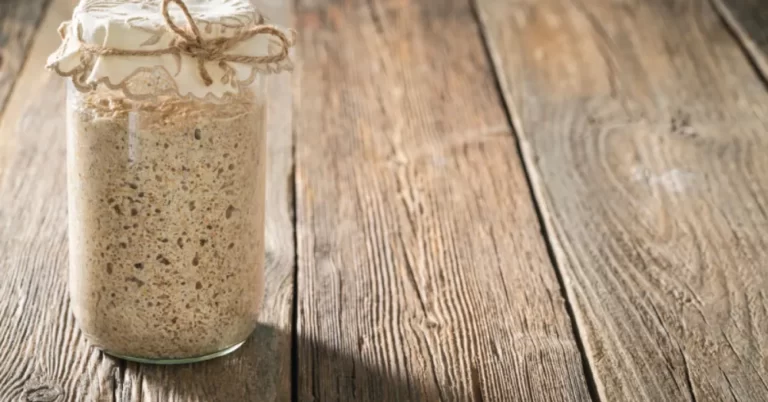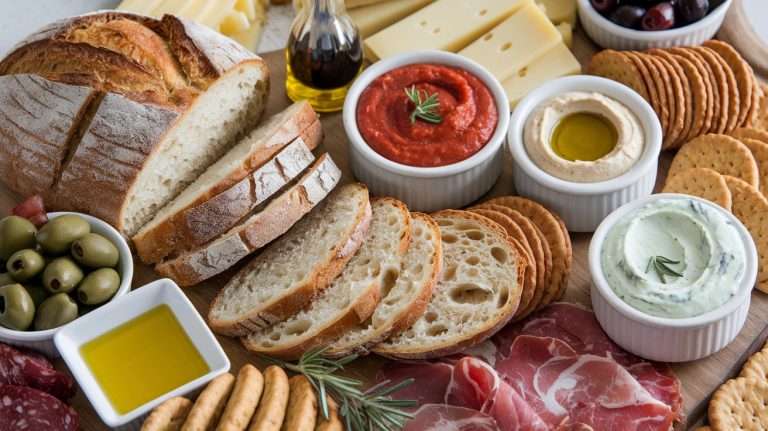Einkorn vs Spelt: Your Grain, Your Choice
If you’re choosing between einkorn and spelt, consider that einkorn is an ancient, simpler wheat with higher nutrient density, easier digestibility, and a nutty, earthy flavor, making it great for denser baked goods. Spelt offers a sweeter taste with fluffier textures due to its higher gluten and is more widely cultivated.
Both support sustainable farming and health, but they differ in gluten content and yield. Exploring their origins and uses reveals why each stands out uniquely.
Key Takeaways
- Einkorn is the first domesticated wheat with simpler genetics, while spelt is a hybrid wheat with more complex genetics from the Bronze Age.
- Einkorn has higher levels of vitamins A, B6, and antioxidants, offering better nutrient absorption and digestibility compared to spelt.
- Spelt contains more gluten than einkorn, resulting in softer, fluffier baked goods, whereas einkorn produces denser, stickier dough.
- Spelt yields more grain per acre and adapts better to varying climates, while einkorn grows taller but produces lower yields.
- Spelt is more widely available and used in diverse products, while einkorn is niche, often marketed as a premium organic ancient grain.
Origin and Historical Background of Einkorn and Spelt
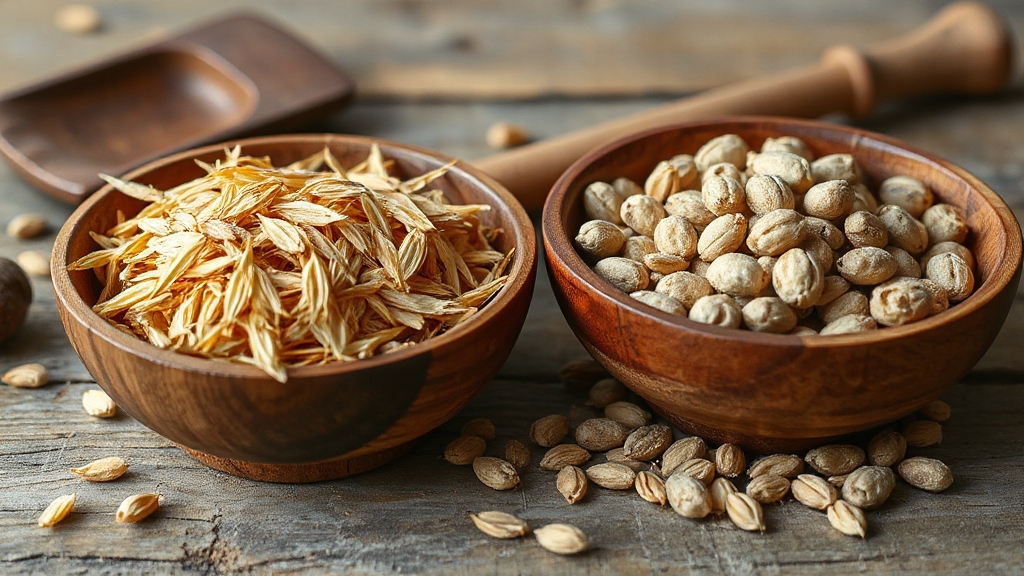
Although einkorn and spelt are both ancient grains, they originated in distinct regions and periods, shaping their early cultivation and historical roles differently. Einkorn began around 7500 BC in the Fertile Crescent, particularly near the Kacara Dag mountains in Turkey, making it one of the first grains domesticated by humans.
It spread to the Middle East, Transcaucasia, and parts of Europe. It is classified as “covered wheat” with hulled grains, meaning the kernels remain enclosed in tough husks after harvest. Today, these grains are valued for their nutritional benefits and unique baking qualities.
Spelt, on the other hand, emerged later during the Bronze Age from emmer wheat and was primarily cultivated in Europe’s Danube region. While einkorn was a staple in ancient diets, spelt gained significance in medieval Europe due to its hardiness.
Both grains experienced cultivation declines but have seen modern revivals because of their unique agricultural and nutritional qualities. You’ll find their histories reflect distinct adaptations to their environments and human needs.
Nutritional Composition Comparison
You’ll find that both einkorn and spelt offer impressive vitamin and mineral profiles, with einkorn standing out for higher B6 and A vitamins and rich mineral content like potassium and phosphorus. Both grains can be effectively cooked using steaming techniques to preserve their nutrient content.
When it comes to fiber and protein, both grains provide significant amounts, but their protein quality and digestibility differ due to unique gluten compositions. Einkorn has a simpler genetic structure with only 14 chromosomes, compared to spelt’s 42, which contributes to its potentially easier digestion.
Additionally, antioxidants such as carotenoids contribute to their health benefits, while einkorn’s gluten structure may be easier to digest for some individuals. Both grains’ hulls protect against pests and chemicals, making them well-suited for organic farming.
Vitamin and Mineral Content
When comparing the vitamin and mineral content of einkorn and spelt, einkorn clearly takes the lead in several key nutrients that support overall health. Einkorn contains 3–4 times more beta-carotene and lutein than spelt, enhancing eye health and immune function. It also provides 4–5 times more riboflavin (B2) and higher levels of vitamin B6, which aid metabolism and nervous system health.
Both grains supply iron, phosphorus, manganese, zinc, and selenium, essential for oxygen transport, bone health, digestion, and immune defense. However, einkorn often offers slightly higher bioavailability of these minerals. Additionally, einkorn’s richer antioxidant profile, including carotenoids and polyphenols, helps protect cells from oxidative stress.
Known as one of the oldest cultivated crops, einkorn carries significant cultural importance alongside its nutritional advantages. Incorporating ancient grains like einkorn into modern diets can be compared to the artistry in sourdough bread that enhances both nutritional value and aesthetic appeal.
Fiber and Protein Levels
Since fiber and protein are essential components for digestive health and muscle maintenance, understanding their levels in einkorn and spelt helps you make informed dietary choices.
Einkorn boasts higher protein content than spelt, providing essential amino acids that support muscle and bone repair. Its simpler protein structure may also enhance digestibility. Einkorn contains lower levels of specific gliadins, potentially making it more digestible for some individuals. Accurate measurement of these components is crucial, similar to how precision in baking scales ensures consistent results in sourdough preparation.
Both grains offer substantial dietary fiber, with einkorn typically containing more, which aids digestion and helps regulate blood sugar. The fiber in these ancient grains is more readily absorbed than in modern wheat, contributing to improved digestive health and reduced chronic disease risk. Reliable measurement increments are important in nutritional analysis to guarantee the accuracy of such comparisons.
While spelt has slightly less protein and fiber, it remains a nutritious option. Choosing between them depends on your dietary needs, but both grains surpass modern wheat in fiber and protein density.
Antioxidants and Digestibility
Although both einkorn and spelt offer valuable antioxidants that protect your cells from oxidative damage, einkorn stands out for its simpler genetic makeup and lower gluten content, which generally make it easier to digest. Einkorn’s gluten has a higher gliadin to glutenin ratio (2:1) but yields less gluten overall, reducing digestive discomfort for many people compared to spelt, whose gluten structure resembles modern wheat.
This genetic simplicity also facilitates better nutrient absorption when you consume einkorn. Freezing techniques that preserve the grain’s nutritional quality can further enhance these benefits by maintaining resistant starch formation.
Both grains provide antioxidants that neutralize free radicals, helping prevent oxidative stress-related diseases, but einkorn often boasts higher nutrient density. Additionally, sourdough fermentation enhances the bioavailability of minerals, proteins, and soluble fibers in these grains, improving their nutritional benefits through fermentation processes.
Differences in Baking Properties
Because spelt contains more gluten than einkorn, you’ll find it easier to handle in baking, especially if you can tolerate gluten well. Spelt dough is less sticky and can replace modern wheat at a 1:1 ratio, making it beginner-friendly.
It produces a higher rise and a crisper crust, delivering a sweeter, wheat-like flavor. This versatility is similar to how sourdough discard can be used to enhance flavor and reduce waste in recipes like chicken pot pie with its tangy sourdough crust.
In contrast, einkorn dough is stickier and wetter, requiring less liquid and specific recipes to manage its weaker gluten and slack texture. Einkorn bread tends to be denser with a nuttier taste. These grains have a delicate gluten structure, impacting dough handling and baking performance.
Both grains need longer hydration and benefit from cold proofing, but spelt is easier to shape despite initial stickiness. Adapting recipes for einkorn improves texture and rise, while spelt’s versatility lets you swap it in most traditional wheat recipes seamlessly.
Cultivation Practices and Yield Variations
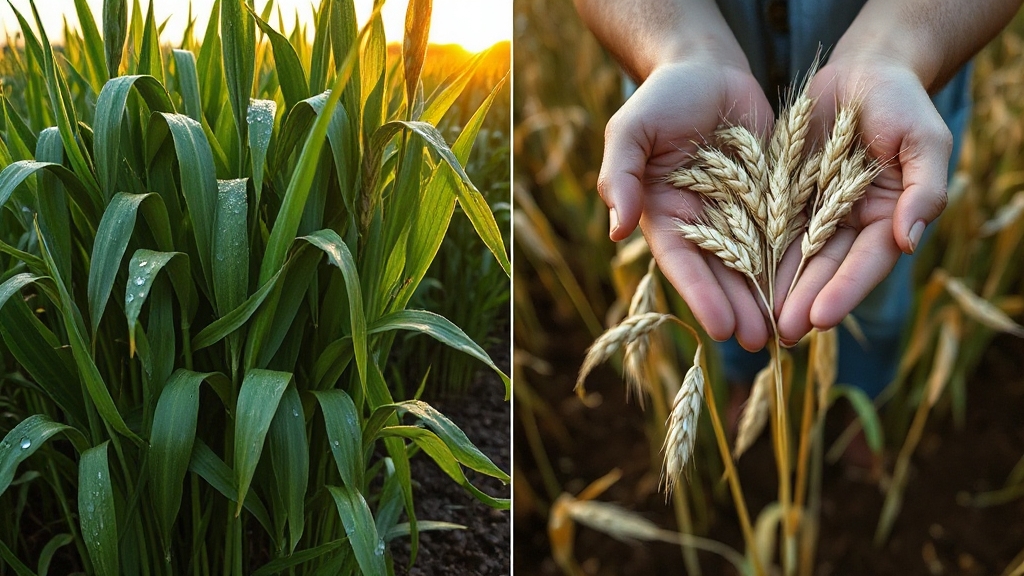
Understanding how einkorn and spelt grow in the field helps explain their differing baking traits and availability. Spelt seeds are planted at about 80–100 lbs per acre, typically at 1¼ inches deep.
Einkorn seeds, at around 100 lbs per acre, show flexibility in seeding rates. Spelt consumes more soil nutrients and generally yields about 2900 lbs per acre, roughly 70% kernel yield, higher than einkorn’s lower output.
Einkorn adapts better to challenging climates and diverse soils but produces fewer plants per area with more spikes per plant. However, both hulled wheats tend to have lower grain yields compared to bread wheat, with einkorn yields being about 62% lower. These yield differences influence decisions on using either grain for sourdough baking.
- Spelt requires more nutrients and moderate climate conditions.
- Einkorn thrives in harsher environments and variable seeding depths.
- Both grains have appreciably lower yields than modern wheat, influencing economic viability.
Culinary Applications and Flavor Profiles
When you explore the culinary uses of einkorn and spelt, their distinct flavor profiles and baking characteristics become immediately apparent. Einkorn offers a deep, nutty, slightly sweet taste with an earthy, rich aroma and a golden flour hue due to carotenoids.
It yields denser, heartier baked goods and requires less liquid, as the dough is stickier and less elastic. Einkorn is also known for having a lower gluten content, which contributes to its unique dough handling properties. Its nutty flavor and improved digestibility make it a standout choice among ancient grains.
Spelt, by contrast, has a sweeter, milder flavor and a light wheaty aroma. Its flour is paler, and dough behaves more like modern wheat, allowing easy 1:1 substitution. Spelt produces softer, fluffier textures, making it versatile for breads, pasta, cereals, and desserts. Combining low-gluten spelt flour with stronger flour enhances flour structure and creates unique flavor profiles.
Both grains excel in whole grain dishes, granola bars, and salad toppings, with einkorn imparting robust depth and spelt offering gentle sweetness.
Health Implications and Digestibility
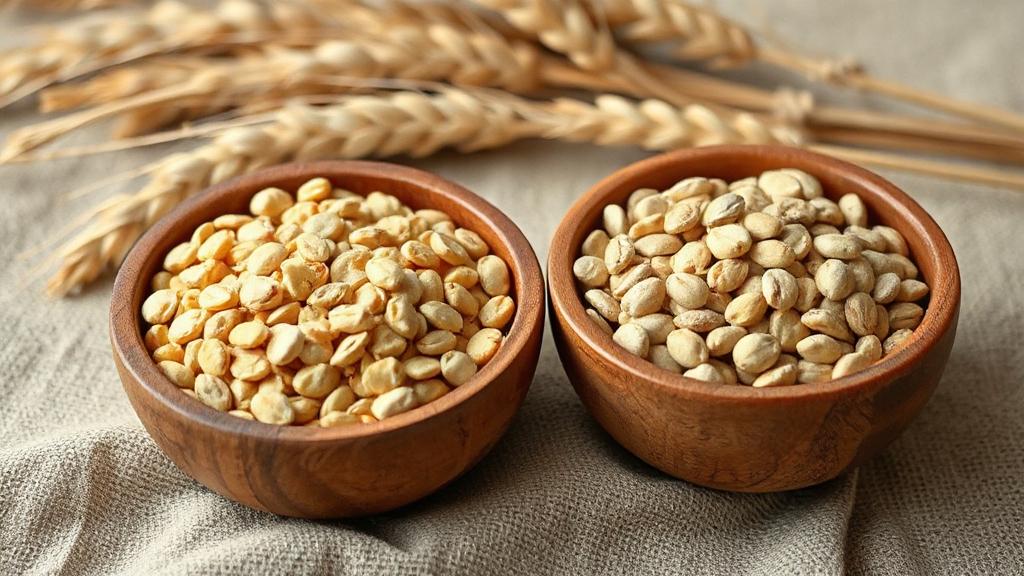
You’ll find einkorn easier to digest than spelt due to its simpler genetic makeup and lower gluten content, which reduces common digestive complaints. This is because einkorn contains higher gliadin and less gluten, resulting in less elasticity and rise in baked goods. Spelt’s higher gluten levels and genetic similarity to modern wheat can trigger sensitivities in some individuals.
Both grains offer substantial nutritional benefits, but einkorn’s nutrients are often more bioavailable, supporting better absorption and overall health. Additionally, including high fiber content from whole grains like einkorn and spelt can promote healthy digestion and satiety.
Digestive Ease Comparison
Although both einkorn and spelt provide valuable nutrients that support digestive health, einkorn stands out for its genetic simplicity and prebiotic effects, which make it easier to digest for many people. Its fewer chromosomes and bioavailable nutrients promote a diverse gut microbiome, supporting beneficial bacteria like Bifidobacteria and Lactobacilli.
Spelt, on the other hand, offers higher fiber content, aiding digestion through increased gut motility.
When comparing digestive ease, consider these key factors:
- Einkorn’s prebiotic properties enhance intestinal mucosa and reduce inflammation.
- Spelt’s fiber and protein content support sustained digestive energy.
- Many consumers report fewer digestive complaints and better tolerance with einkorn due to its simpler genetic structure and gut-friendly effects.
Gluten Content Differences
Because einkorn has a simpler genetic structure and lower gluten content than many modern wheat varieties, it often digests more easily for individuals sensitive to gluten. Einkorn’s gluten constitutes about 77% of its total flour proteins, with a higher gliadin to glutenin ratio than spelt, which impacts gluten strength and digestibility.
Additionally, einkorn contains little to no protein substances that trigger wheat intolerance, making it a potentially better option for sensitive individuals wheat intolerance. Measuring the precise gluten content in grains is important for recipe adjustments and baking accuracy, which can be aided by using measurement accuracy tools.
Spelt contains more gluten than einkorn but less than modern wheat, providing better dough elasticity and rise. This difference means einkorn’s gluten may reduce allergenic potential and aid digestion in those with mild gluten sensitivity, though it’s still unsuitable for celiac sufferers.
However, lower gluten in einkorn affects baking properties, requiring recipe adjustments. Understanding these gluten content differences helps you choose the grain that best fits your digestive tolerance and culinary needs.
Nutritional Impact Benefits
Beyond gluten content, einkorn and spelt offer distinct nutritional benefits that impact your overall health and digestion. Einkorn’s simpler genetic makeup often makes it easier to digest and may improve nutrient absorption, reducing gastrointestinal discomfort and inflammation for sensitive individuals.
Both grains provide high protein, fiber, vitamins A and B, and minerals like phosphorus and zinc, supporting muscle, bone, immune, and eye health.
Consider these key points:
- Digestive Ease: Einkorn’s genetic simplicity enhances digestibility and nutrient uptake.
- Immune & Bone Support: Zinc and phosphorus in both grains strengthen immunity and bone development.
- Antioxidant Protection: Their antioxidants help protect your cells from oxidative damage.
Environmental Adaptability and Growth Conditions
When you compare einkorn and spelt, you’ll find that spelt adapts more readily to varying climates thanks to its unique genetic makeup, which includes a third genome from wild grass. This genetic advantage enables spelt to tolerate moisture stress and diverse temperature ranges better than einkorn.
Both ancient wheats excel in low-input systems, thriving on minimal fertilizers due to einkorn’s and emmer’s high nitrogen use efficiency, which also reduces nitrate pollution. Despite their generally low yields, these species demonstrate higher nitrogen productivity, making them suitable for sustainable agriculture in marginal areas nitrogen productivity.
Einkorn tends to be taller with a more upright growth pattern, whereas spelt grows more prostrate.
Both require full sun and well-drained soils with balanced pH. However, they’re sensitive to lodging and need careful disease and pest management.
Their sustainability and resilience make them valuable for organic farming and ecological biodiversity.
Market Availability and Consumer Preferences
Understanding the environmental adaptability of einkorn and spelt sets the stage for examining how these grains perform in the marketplace and meet consumer demands. Spelt enjoys broader market availability and is featured in various products, including specialty foods and craft beverages.
Meanwhile, einkorn is gaining traction primarily in organic and specialty markets with higher retail prices. Production of spelt wheat is concentrated mainly in Europe and North America, which supports its strong market presence and availability.
Consumers appreciate both grains for their nutritional benefits, distinct flavors, and perceived health advantages. Market growth is driven by rising interest in ancient grains and sustainable food choices.
- Spelt’s wider product range and moderate pricing versus einkorn’s premium organic positioning
- Consumer focus on nutrition, taste, and sustainability for both grains
- Expanding ancient grain market with innovative food and beverage applications
Frequently Asked Questions
Can Einkorn or Spelt Flours Be Used Interchangeably in Recipes?
You can use einkorn and spelt flours interchangeably in recipes, but you’ll need to adjust liquid amounts and mixing times. Einkorn absorbs liquid slower and requires about one-third less liquid than spelt.
Since einkorn has less gluten, handle the dough gently to avoid over-kneading. Expect differences in texture—einkorn yields denser baked goods, while spelt produces lighter, more elastic results.
Both flours offer a nutty flavor that enhances your recipes.
Which Grain Is More Sustainable to Grow Organically?
Imagine farming with a quill instead of a tractor—organic growing demands care.
You’ll find spelt more sustainable because it yields more per acre, adapts better to varied conditions, and outcompetes weeds without synthetic fertilizers.
While einkorn thrives in poor soil, it’s less resilient and produces less, increasing costs.
Spelt’s versatility and efficiency make it a smarter choice if you aim for eco-friendly, organic grain production with balanced environmental impact.
Do Einkorn and Spelt Require Special Milling Equipment?
You don’t necessarily need special milling equipment for these grains, but there are key differences. Einkorn berries can be milled with most countertop mills like the Mockmill after simple dehulling.
Spelt, however, requires a more intensive dehulling process before milling, sometimes needing specialized gear. Both grains respond well to stone or friction mills, but if you’re milling industrially, advanced machines like Codema VSH 2096 improve efficiency and throughput.
Are There Specific Storage Conditions for Einkorn and Spelt Grains?
Think of storing grains like preserving a fine wine—you wouldn’t leave it in sunlight or a warm room. You’ll want to keep Einkorn and Spelt in cool, dry, dark places between 50-70°F, using airtight containers to prevent moisture and pests.
Freezing for 48 hours helps kill insect eggs. Use oxygen absorbers with sealed mylar bags for long-term freshness, and label dates to rotate stock efficiently.
How Do Einkorn and Spelt Affect Blood Sugar Levels Differently?
You’ll notice einkorn causes a slower, steadier rise in blood sugar due to its low glycemic index (around 45) and lower simple sugar content. Its higher protein and nutrient density also slow digestion, helping stabilize glucose levels.
Spelt, with slightly more sugars and a moderate glycemic index, tends to raise blood sugar more quickly.
Choosing einkorn supports better blood sugar control and may reduce diabetes risk more effectively than spelt.
Chart Your Course Through Ancient Grain Excellence
Choosing between einkorn and spelt is like picking between two ancient rivers, each carving its own path through history and nutrition. Einkorn flows with simplicity and digestibility, while spelt rushes with robust flavor and baking strength.
Understanding their origins, cultivation, and health impacts lets you navigate your culinary journey with confidence. By knowing their unique currents, you’ll make informed choices that nourish your body and respect the environment, no matter which grain you sail with.

